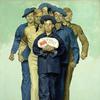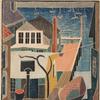The 25th Paris Biennale : a moment of excellence
- PARIS, France
- /
- September 23, 2010
The 25th Paris Biennale closes with resounding success. More than 65,000 visitors discovered works of art presented by 80 art dealers and 7 jewellers that turned the Grand Palais into an ephemeral museum.
All agree that the 25th Paris Biennale succeeded in attracting art lovers and collectors from France, Europe, America, Russia and China. According to the President of the Biennale and Syndicat National des Antiquaires Hervé Aaron this year's Biennale stands out thanks to its new image: "It combined the excellence of the objects, the modernity of the decor and a number of transactions that confirm the market has reawakened after the crisis."
Comments such as "readability of the space", "clarity of the plan," "positive ambiance," "quality of the objects" are repeatedly offered by the visitors.
In the field of 20th century painting, the Tornabuoni gallery, whose stand combined contemporary and old masters, has concluded several sales including that of a work by Morandi, a 1956 Fontana and a Roman Baroque console.
As explained by Franck Prazan of the Applicat-Prazan gallery, demand is firm for significant works by important artists that have a patrimonial dimension. These works attract private collectors as much as institutions. The Zlotowski gallery announces a definite enthusiasm for the entirety of its stand whose showpiece, Bull VII, 1954 by le Corbusier was sold as well as numerous collages and gouaches by the same artist.
The Marlborough gallery confirms strong interests in its Francis Bacon triptych while the Galerie de la Présidence notes "a clear increase in demand compared to 2008". Numerous sales have been confirmed for both works on paper and oils on canvas.
Reports are also very positive in the field of 20th century furniture, as important sales took place notably for the galleries Downtown and Yves Gastou as well as the Galerie Vallois that sold all the lacquer pieces by Jean Dunand on display.
According to Patrice Bellanger, specialised in old master sculpture, the 25th Biennale is "a great critical and commercial success": significant works with reassuringly famous signatures have found a buyer.
In a different field, that of 20th century sculpture, Pierre Dumonteil explains that the dealer's choice reassures the collector and awakens his interest for little known artists put in the spotlight. This is notably the case for Georges-Lucien Guyot (1885-1973) or Charles Artus (1897-1978) whose reputations were definitively established.
In Ancient Art the Phoenix gallery announces also its great satisfaction and considers the Paris Biennale to be one of the world's most beautiful fairs. Among the many pieces that were sold, the Important idol in ceramic (Iranian art Amlach, late 2nd-early 1st mill. B.C) was acquired by a European private art collector. It was also a resounding success for Axel Vervoordt whose speciality is to juxtapose objects in an elegant and subtle mix of genres. Its Nuremberg cabinet, a collection of Egyptian vases in alabaster, a Roman Venus after the Greek sculptor Polycles (Roman period), a Neoclassical Milanese Empire table stamped Ripamonti as well as many archaeological objects from Asia, Egypt and Mesopotamia have been sold.
In the field of Asian arts, the gallery Gisèle Croës from Brussels announces a true commercial success on her stand that was widely admired. Among the many pieces that were sold we can mention the Archaic bronze Lei of the Spring and Autumn Period (770-481 B.C.) and the Jizo Bosatsu, Japan, Muromachi Period (1392-1573). A first-time exhibitor at the Biennale, the gallery Jean-Christophe Charbonnier has sold several pieces to French and European collectors, notably its Suji-bachi helmet decorated with a lobster from the late Momoyama-early Edo period.
Specialising in silverware, the gallery Bernard de Leye sold more than twenty pieces of French and European silverware, notably the earliest known Louis XV ewer and its basin as well as plates from the service of Catherine the Great. The Chadelaud gallery notes the return of American clients and mentions among its sales a pair of busts by Charles Cordier and a clock in amethyst created for Henri V that went to private collectors as well as strong interest from institutions. The Kraemer gallery notices a very strong interest for 18th century furniture on the part of European, American and Russian collectors.
A positive impression also for Sabine Bourgey, specialised in numismatic, who thinks that the Biennale has attracted a public that is younger and with an important financial power. Among her many sales, she mentions an Aureus of Septimius Severus (193-211) whose reverse, very rare, shows the deity Carthage seated frontally on a lion.
Numerous museum curators visited the fair and confirmed their interest: a Minaï vase from the Kervorkian Gallery was acquired by the Musée du Louvre while the Musée d'Orsay placed an option on a bench presented by Franck Laigneau.
In the jewellery section, the satisfaction is unanimous: "Today the Biennale is a prestigious and international showcase for the creations of Van Cleef & Arpels" declares Stanislas de Quercize, the firm's President.
Launched to place the new generation of art dealers in the spotlight, the Stepping Stone to the Biennale was a success. Among the works selected many were sold: a pair of bergere seats by Paul Poiret (Galerie Mathivet), a court lady, called Fat lady with a mirror, Tang dynasty, 8th century (Galerie Eric Pouillot), the painting Eclatement by Judit Reigl (Kalman Maklary Fine Art), the seat Elysée by Pierre Paulin (Galerie de Casson), a medal of the Order of the légion d'honneur set with diamonds and enamelled at the back (Jean-Christophe Palthey) and the oil on canvas Le Rivage heureux by
Lucien Weil (Vincent Lécuyer).
Finally, around the Paris Biennale, a number of important exhibitions in many specialities were organised, thus proving that this federative event helps fostering culture in Paris and strengthening the art market.
"This Biennale is a tremendous success. As president of the Syndicat National des Antiquaires and organiser of the Biennale, I think that it is a crucial moment of expression for the dealers who are the vital forces of the art market. The Biennale must get stronger, bigger and more international and it will keep on breathing life into the French market" concludes Hervé Aaron.
















